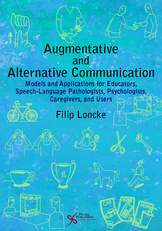Publication
Augmentative and Alternative Communication
Models and Applications for Educators, Speech-Language Pathologists, Psychologists, Caregivers, and Users
- Details:
- 248 pages, Illustrated (B/W), Softcover, 7 x 10"
- ISBN13:
- 978-1-59756-498-4
- Release Date:
- 02/25/2014
Overview
Augmentative and Alternative Communication: Models and Applications for Educators, Speech-Language Pathologists, Psychologists, Caregivers, and Users aims to be the primary text for graduate courses in augmentative and alternative communication (AAC). The book contains 13 chapters--the ideal length for a 13-week semester course--that provide an in-depth overview of the subject. Each chapter also includes a section with practical applications and potential class activities.
The author, Filip Loncke, PhD, has practiced and conducted research in AAC and AAC-related matters since 1990 and has taught AAC courses at the graduate level since 2000. Dr. Loncke recognized that due to the ever-evolving nature of the field, which in many ways is linked to developing technology, it was crucial to develop a book that details the framework of how communication is shaped by internal and external factors (including technology) and how communication affects social functioning as well as other (mainly cognitive) functions.
The text references psycholinguistics, communication sciences, social psychology, and other disciplines to explain AAC and provide students with a thorough review of the subject.
Introduction
Acknowledgements
- Chapter 1. AAC: A General Introduction
- Chapter 2. Access, and Message Management
- Chapter 3. Non-tech, Low-tech, High-tech, and Mobile Computing
- Chapter 4. The Use of Symbols
- Chapter 5. Vocabulary and AAC
- Chapter 6. AAC Intervention at the Prelinguistic Level
- Chapter 7. Language Intervention and AAC
- Chapter 8. AAC and Intervention with Acquired Communication Disorders
- Chapter 9. AAC and Literacy Development
- Chapter 10. Augmentative and Alternative Communication and Natural Speech
- Chapter 11. AAC and Assessment
- Chapter 12. AAC and the Community
- Chapter 13: The AAC Experience
Index
About The Author
Filip Loncke has practiced and conducted research in AAC and AAC-related matters since the 1990s and taught AAC courses at University level (graduate level) since 2000.
Related Titles
Augmentative and Alternative Communication
320 pages, Illustrated (B/W), Softcover, 7 x 10"
Augmentative and Alternative Communication Intervention
288 pages, Illustrated (B/W), Softcover, 7 x 10"
Autism: Attacking Social Interaction Problems
Co-Authors: Betholyn F. Gentry, Pamela Wiley
176 pages, Illustrated (B/W), Softcover, 8.5 x 11"
Autism: Attacking Social Interaction Problems
Co-Authors: Pamela Wiley, Betholyn F. Gentry, Jamie Torres-Feliciano
392 pages, Illustrated (B/W), Softcover, 8.5 x 11"
Autism: Attacking Social Interaction Problems
Co-Authors: Betholyn F. Gentry, Pamela Wiley, Jamie Torres-Feliciano
252 pages, Illustrated (B/W), Softcover, 8.5 x 11"
Autism: Attacking Social Interaction Problems
Co-Authors: Pamela Wiley, Betholyn F. Gentry
296 pages, Illustrated (B/W), Softcover, 8.5 x 11"
Deductive Reasoning Exercises for Attention and Executive Functions
194 pages, Illustrated (B/W), Softcover, 8.5 x 11"
Aphasia Rehabilitation: The Impairment and Its Consequences
Nadine Martin, Ph.D., Cynthia K. Thompson, Ph.D., Linda Worrall, Ph.D.
277 pages, Illustrated (B/W), Softcover, 6 x 9"
Aphasia Couples Therapy (ACT) Workbook
132 pages, Illustrated (B/W), Softcover, 8.5 x 11"
Adult Neurogenic Language Disorders
392 pages, Illustrated (B/W), Softcover, 7 x 10"
Hearing Assistive and Access Technology
Samuel R. Atcherson, Clifford A. Franklin, Laura Smith-Olinde
320 pages, Illustrated (B/W), Softcover, 7 x 10"
Patient-Provider Communication
Edited by: Sarah W. Blackstone, David R. Beukelman, Kathryn M. Yorkston
352 pages, Illustrated (B/W), Softcover, 7 x 10"
Working with Interpreters and Translators
Edited by: Henriette W. Langdon, Terry Irvine Saenz
267 pages, Illustrated (B/W), Softcover, 7 x 10"
Communication and Aging
319 pages, Illustrated (B/W), Softcover, 6 x 9"
Augmentative and Alternative Communication in Acute and Critical Care Settings
Richard R. Hurtig, Ph.D., Debora Downey, CCC-SLP
224 pages, Illustrated (B/W), Softcover, 7 x 10"
























